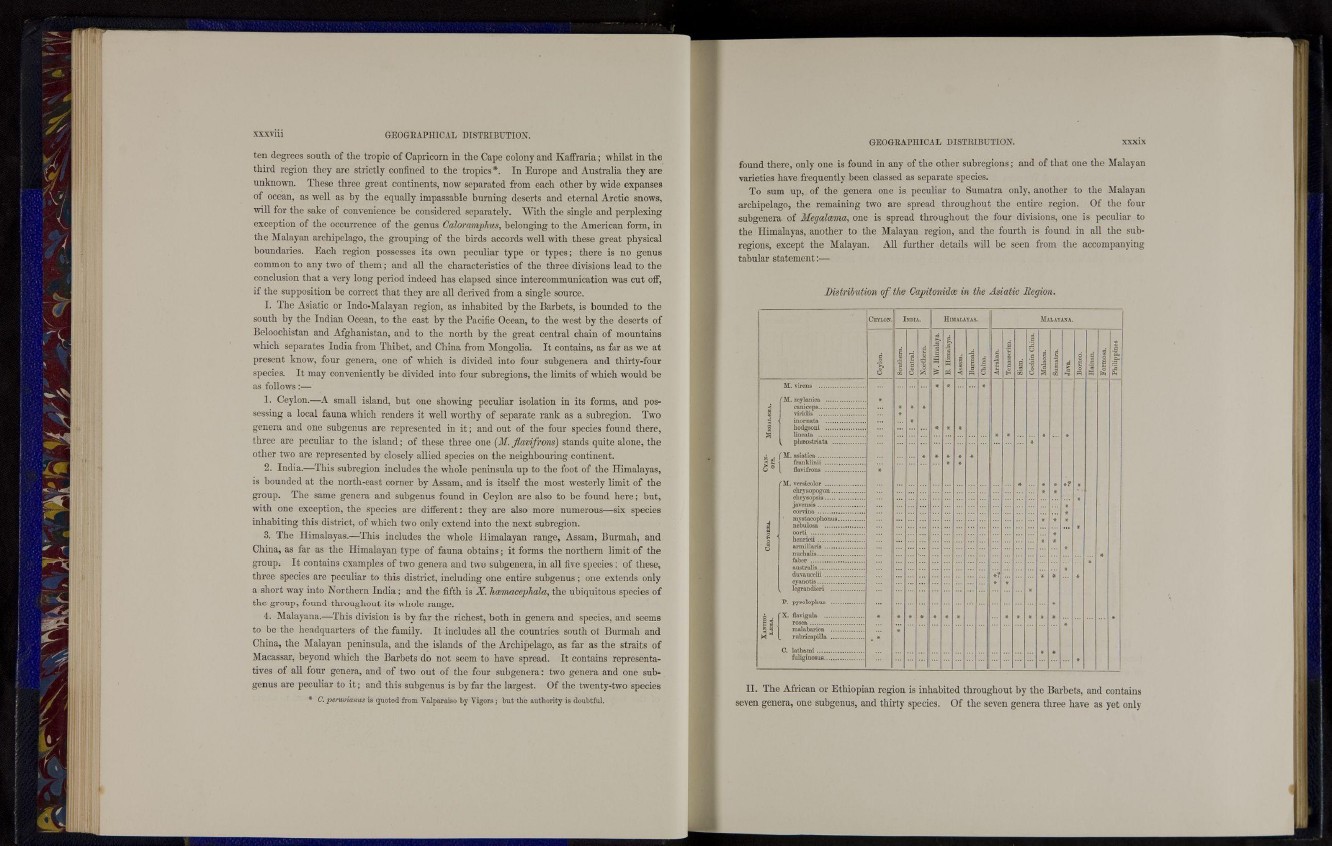
xxxviii GEOGRAPHICAL DISTRIBUTION.
ten degrees south of the tropic of Capricorn in the Cape colony and Kaffraria; whilst in the
t h i rd region they are strictly confined to the tropics*. In Europe and Australia they are
unknown. These three great continents, now separated from each other by wide expanses
of ocean, as well as by the equally impassable burning deserts and eternal Arctic snows,
will for the sake of convenience be considered separately. With the single and perplexing
exception of the occurrence of the genus Caloramphus, belonging to t h e American form, in
t h e Malayan archipelago, the grouping of the birds accords well with these great physical
boundaries. Each region possesses its own peculiar type or types; there is no genus
common t o any two of them; and all the characteristics of the three divisions lead to the
conclusion that a very long period indeed has elapsed since intercommunication was cut off,
if t h e supposition be correct that they are all derived from a single source.
I. The Asiatic or Indo-Malayan region, as inhabited by t h e Barbets, is bounded to the
south by the Indian Ocean, to the east by t h e Pacific Ocean, to the west by t h e deserts of
Beloochistan and Afghanistan, and to the north by the great central chain of mountains
which separates India from Thibet, and China from Mongolia. It contains, as far as we at
present know, four genera, one of which is divided into four subgenera and thirty-four
species. It may conveniently be divided into four subregions, t h e limits of which would be
as follows:—
1 . Ceylon.—A small island, but one showing peculiar isolation in its forms, and possessing
a local fauna which renders it well worthy of separate rank as a subregion. Two
genera and one subgenus are represented in i t ; and out of the four species found there,
three are peculiar to the island; of these three one (M. Jtavifrons) stands quite alone, the
other two are represented by closely allied species on the neighbouring continent.
2. India.—This subregion includes t h e whole peninsula up to the foot of the Himalayas,
is bounded at the north-east corner by Assam, and is itself the most westerly limit of the
group. The same genera and subgenus found in Ceylon are also to be found here; but,
with one exception, the species arc different: they are also more numerous—six species
inhabiting this district, of which two only extend into the next subregion.
3. The Himalayas.—This includes the whole Himalayan range, Assam, Burmah, and
China, as far as the Himalayan type of fauna obtains j it forms the northern limit of the
group. It contains examples of two genera and two subgenera, in all five species: of these,
three species are peculiar to this district, including one entire subgenus; one extends only
a short way into Northern I n d i a ; and the fifth is X. haimaccphala, the ubiquitous species of
t h e group, found throughout its whole range.
4. Malayana.—This division is by far the richest, both in genera and species, and seems
to be t h e headquarters of the family. It includes all the countries south ot Burmah and
China, the Malayan peninsula, and the islands of the Archipelago, as far as the straits of
Macassar, beyond which the Barbets do not seem to have spread. It contains representatives
of all four genera, and of two out of the four subgenera: two genera and one subgenus
are peculiar to i t ; and this subgenus is by far the largest. Of the twenty-two species
* C. peruvianus is quoted from Valparaiso by Vigors; but the authority is doubtful.
GEOGRAPHICAL DISTRIBUTION. xxxix
found there, only one is found in any of the other subregions ; and of t h a t one the Malayan
varieties have frequently been classed as separate species.
To sum up, of the genera one is peculiar to Sumatra only, another to the Malayan
archipelago, the remaining two are spread throughout the entire region. Of the four
subgenera of Megaloema, one is spread throughout the four divisions, one is peculiar to
the Himalayas, another to the Malayan region, and the fourth is found in all the subregions,
except the Malayan. All further details will be seen from the accompanying
tabular statement :—
Distribution of the Asiatic Region.
CEYLON INDIA. HIMALAYAS. MALAYANA.
i
c"fie J
to
1
S =
tí
S 1
4
.=
O
j
I i
I
1
O
e
C
i
i •J- 4
1
1
î g
1
11
i
Î
virens : * » *
. zeylanica caniceps *
mornata
hodgsoni
lincata „ _
pboeostriata
*
asiática *
franklinii
flavifrous
versicolor #?
chrysopogon
cbrysopsis
javensis
*
corvina
mystacophonus
nebulosa
"* *
*
hciiricii
annularis
nuchalis
faber *
nustralis *
duvaucelii # «
cyanotis
legrandieri *
*
• * * - » • *
*
*
*
lathami
I I . The African or Ethiopian region is inhabited throughout by the Barbets, and contains
seven genera, one subgenus, and thirty species. Of the seven genera three have as yet only